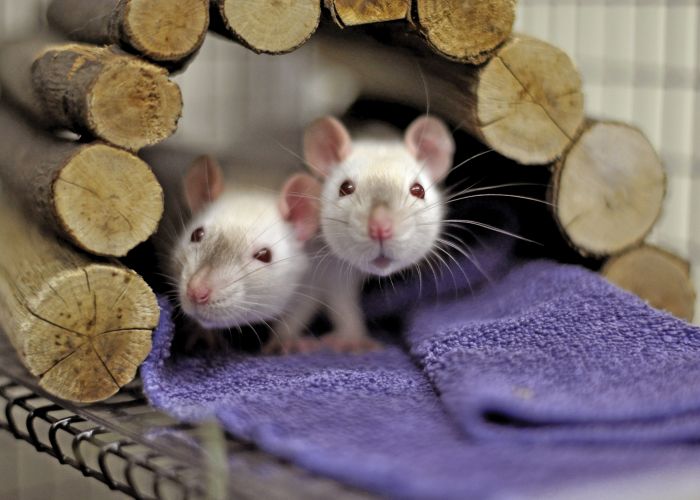Emotional rescue
Understanding why it’s crucial for animals in our care to feel good

Health is not complete if only the body is sound. Being healthy means being sound in body, mind and spirit. When we are healthy, we feel good—physically and emotionally.
In fact, many would argue that a mental ailment is often more debilitating than a physical one. Which would you rather endure: an upper respiratory infection or an anxiety disorder? And what if you had both ailments at once—would you expect to recover from your cold quickly if you were also feeling upset and anxious? Can you imagine how it would affect others to be around you when you were sick and anxious?
The same questions apply to the animals in our care. Think about it: Shelters and foster caregivers strive to keep animals healthy while they await new homes. Providing for animals’ basic physical needs involves major commitments of time and resources. The animals depend on us for shelter, nutrition, parasite control, grooming, basic medical care and more. At the same time, they rely on us to ensure that their basic emotional needs are fulfilled and that their emotional health is bolstered.
That is a tall order. Yet our ultimate task is to ensure that our animals feel good because it is crucial for their overall health. It is not only beneficial for them, but also for those around them, because feeling good can literally be contagious. As that positive energy spreads, it helps animals to connect with potential adopters— and that may be their fast-track ticket to a loving home.
Feeling All Right
Good emotional or mental health implies a state of psychological or behavioral well-being. When animals possess good emotional health, they are able to effectively function, learn and adapt in everyday life.
Emotionally healthy animals regularly express a variety of pleasure and comfort states including serenity, joy, playfulness and excitement. If faced with a stressful situation, they are able to cope, and they bounce back without remaining anxious or on edge. They do not experience significant or prolonged stress, fear, anxiety, rage, depression, frustration or other negative emotional states. In short, emotionally healthy animals are content and resilient and enjoy their everyday lives.
With training and experience, we can ascertain a great deal about an animal’s emotional health by carefully watching what he does and what he doesn’t do. By observing, we can deduce what animals are experiencing emotionally; we can accurately interpret their body language and vocalizations and understand more passive forms of communication such as withdrawing from normal behaviors—by not eating or grooming—or withdrawing from healthy activities or social interactions. We can also get a handle on how they are feeling when we recognize displays of abnormal behavior like repetitive spinning, constant hiding or continual barking.

Shelter Impacts on Emotional Health
When confined in an animal shelter, cats and dogs experience a wide range of emotions that profoundly affect their emotional health in the short term and may also have long-term impacts. This is particularly true if they become sensitized to people, places or things that trigger their fear or frustration on an ongoing basis, or when stress and its associated negative emotional states are prolonged.
Most of us have witnessed the emotional toll that overwhelming stress can take on people and animals. We have seen situations where we recognized that “he was never quite the same after X, Y or Z happened.” Like people, animals are emotionally sensitive (some more so than others)—and traumatic experiences can sometimes cause permanent emotional scars that may be difficult, or even impossible, to overcome. Indeed, animals’ experiences in a shelter can impact their emotional health for the rest of their lives.
Emotional health also greatly influences physical health. Acute stress can reduce appetite, cause upset stomachs and exacerbate existing medical conditions including heart disease, hormone imbalances, urinary tract disease and allergies. Chronic stress compromises the immune system, lowering resistance to infection. The link between stress and feline respiratory disease (especially infection with feline herpesvirus-1, or FHV-1), for example, is well-established. Plain and simple, stressed animals are more likely to develop illness from infectious diseases—and are slower to recover from them—than those who experience less stress.

Through the Animals’ Eyes
Imagine your own pet confined in an animal shelter. From the moment of admission, the strange sights, smells and sounds, combined with the presence of unfamiliar people and animals, would at the very least immediately trigger apprehension. Depending on his personality and prior socialization and experience, he might experience more or less profound anxiety or fear than others. He might demonstrate an array of responses—some animals panic and try to escape, some freeze and become catatonic, some behave aggressively, and some simply appear reserved, tense or uneasy.
Confinement in an unfamiliar environment makes coping difficult for animals. After all, it is generally challenging for animals in shelters to engage in normal everyday behaviors. In tight confinement, they have little control and few behavioral options that might serve as effective outlets for their emotions and needs. They can’t ask to go out to potty. They never know who is going to appear in front of their cage. The day-to-day interactions they experience may be inconsistent and unpredictable, making it difficult for them to learn what to expect and adapt accordingly. Over time, frustration often mounts, and many individuals will continue to experience fear or anxiety.
If left unaddressed, the negative emotional states that animals in shelters experience lead to poor emotional health and compromised welfare. Dogs and cats who display signs of fear and frustration may be misunderstood. They may be viewed as having “problem” behaviors, causing them to be labeled “that crazy dog” or “that mean cat who always messes up his cage.” Meanwhile, their behavior may make it increasingly less likely that they will be adopted. You know the vicious cycle: Longer shelter stays increase the odds of continued behavioral deterioration. Ultimately, emotional trauma may cause behavioral problems such as chronic fear, anxiety, depression or aggression. And if they remain in shelter care indefinitely, they may experience long-term emotional suffering.

Are Emotions Really Contagious?
Yes, emotions can spread like wildfire in a confined population of animals or people. The process of “emotional contagion” is a simple and widespread form of emotional transfer that occurs among animals; upon perceiving the emotions of their fellow shelter residents, animals shift their own emotional state in the same direction. This process can multiply both negative and positive emotions. For example, when animals are afraid, those around them are likely to quickly feel the same way.
To illustrate this concept, imagine yourself entering a building and being confined to a small cell. As you try to get your bearings and cope with what is happening, you look around and begin to realize that all the other people appear scared or confused. What an unnerving experience that would be—and how different would it be if instead, you looked around and saw people who were relaxed and smiling? Automatically, you would feel better, right? Your outlook would be much more positive.
Human psychology research suggests that our emotional state impacts our cognitive function (i.e., how we process information). For example, people in negative states tend to think negatively—they make negative judgments and have a difficult time coping in times of stress. In contrast, people in positive emotional states typically cope much better. It turns out that if we have a positive outlook, we approach the world with an open mind. We do not feel defeated; we are up for the challenge, we learn better, we go further.
An emerging area of animal welfare research is demonstrating that these “cognitive biases” also occur in animals. The implications for shelter animals are great— if they experience more positive emotional states, they are more likely to cope effectively with shelter life.

Exploring Animals’ Emotional Needs
Individual animals possess a wide variety of emotional needs depending on their species, genetic makeup, personality, prior socialization and past experiences. For dogs and cats, emotional needs typically include opportunities for social interactions with humans and other compatible animals; the ability to create different functional areas in their living environments for elimination, resting and eating; the opportunity to hide in a secure place or to rest without being disturbed; the ability to change locations within the environment; the ability to engage in species- typical behaviors such as scratching for cats and chewing for dogs; and regular opportunities to play, exercise and engage in mentally stimulating activities.
It doesn’t take long for animals to settle in and learn the routine when their needs are met. When they are provided with regular, consistent, predictable positive interactions and pleasant activities, they know what to expect and can adapt to the routine. They feel good—and when they do, it helps the animals around them feel good, too.

Accentuating the Positive
The Five Freedoms, which outline standards of animal care for the sheltering and rescue field, are an invaluable benchmark and provide us with a crucial framework. Although the emphasis may appear to be on freedoms from unpleasant experiences (hunger/thirst, discomfort, pain/injury/disease, fear/distress), it is important to realize that health and welfare depend not only on minimizing negative experiences and emotions, but on maximizing positive ones. This brings us to the freedom to express normal behaviors. Simply stated, dogs in shelters need to be able to be dogs—they need outlets to do what dogs naturally do. Likewise, cats need to be able to be cats.
Now, imagine what your own animals choose to do at home. Perhaps they find a cozy cushion and snuggle up for a nap after a bit of self-grooming, then they wake up, stretch and explore the house. Or maybe they grab their leash at 5 o’clock because they know it’s time for a walk and a game of fetch, or they venture into the yard to check out their favorite spot to dig or to find a stick to chew on. They are relaxed for most of the day—excited at times, but not frantic. They look forward to dinnertime, and they anticipate your arrival home from work. They seek out and receive positive, predictable social interactions. They are comforted and content. They are not frustrated. They are not afraid. These are the behaviors and emotions we want to see: How can we see more of them in our shelter animals?
Emotional health is critically important for cats, dogs and other species. Understanding how animals express themselves and what motivates their behavior can enable us to better understand their emotions. Minimizing negative emotional states and maximizing positive ones is key to maintaining proper behavioral welfare. Proper behavioral health care has the potential to greatly improve overall health, decrease infection rates and enhance the adoptability of shelter animals. Let’s face it: It’s good to feel good.








